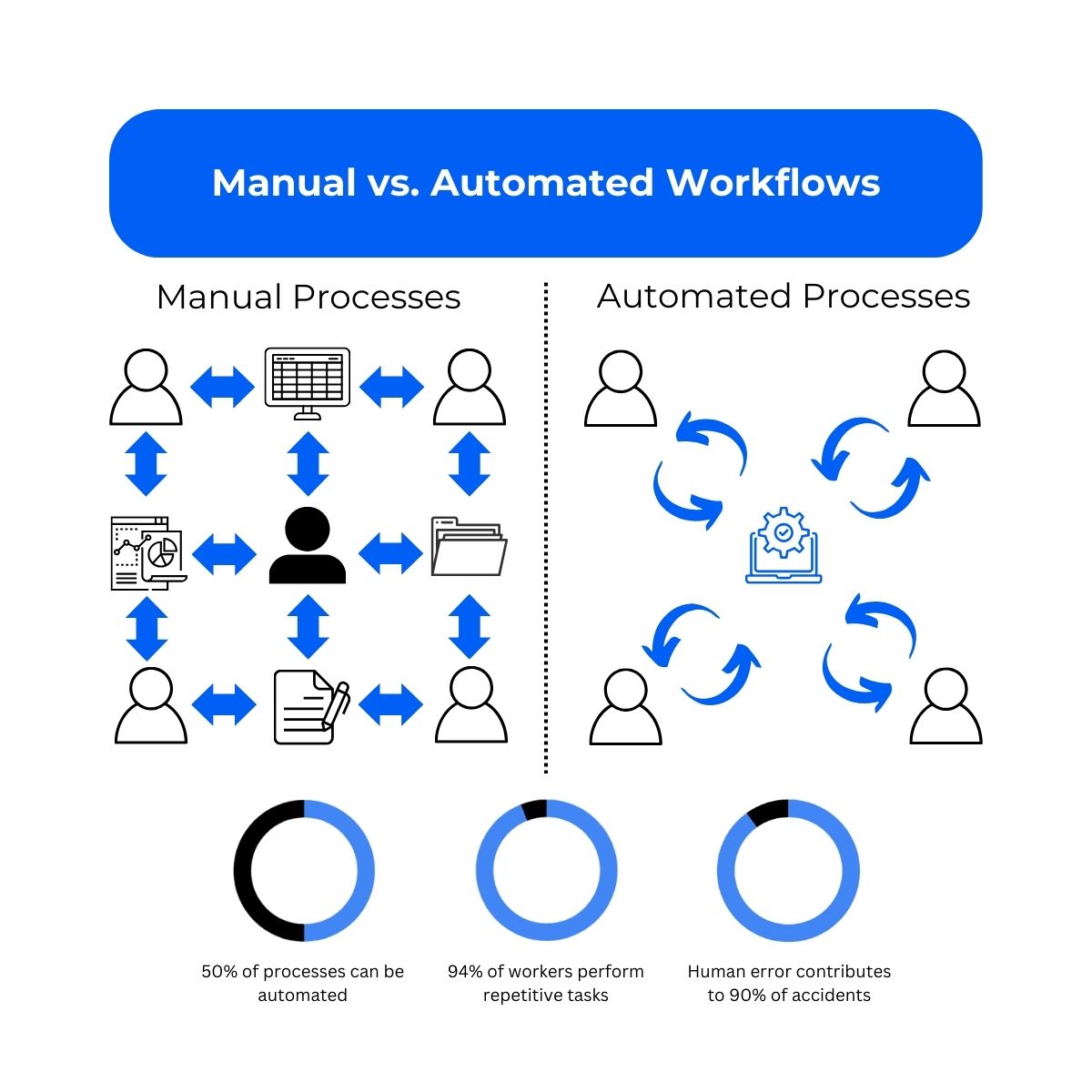Nobody enjoys spending their time on mundane, repetitive tasks. Time is money, and we should invest in activities that add real value to our businesses. If you’ve ever found yourself carrying out one of your day-to-day tasks, thinking “I could train a monkey to do this”, then you’re in luck.
Fortunately, there’s a solution much more convenient than having a team of chimps working away in your office, and that’s workflow automation. Automating your workflows and processes gives you the freedom to focus on the tasks that really matter to your business, so let’s take a look at what this means.
What is Workflow Automation?
Workflow automation, or process automation, is quite simply the use of technology to automate, streamline, and optimise various different processes and tasks within the day-to-day operations of a business. The goal is to improve efficiency, reduce manual effort, minimise errors, and enhance overall productivity. Essentially, you’re utilising tools or platforms to carry out manual tasks for you.
Workflow automation involves defining and mapping out the steps and activities involved in a particular business process; utilising tools or platforms that facilitate the automation of these tasks; and implementing rules and logic to guide the flow of the automated process to ensure that it accurately carries out the task at hand.

Which Business Processes Can Be Automated?
An easier question to answer would probably be “which business processes CAN’T be automated?”, especially with ongoing technological advancements, particularly in AI and robotics, continuing to push the boundaries of what can be automated.
At least 50% of work can be automated , and it’s safe to say workflow automation can be applied across many industries and business functions. Provided that the process in question does not involve highly unpredictable situations or a heavy focus on building relationships, then that same process can likely be automated using digital tools or platforms.
Here are some common areas where workflow automation is frequently applied:
- Document Approval and Management: Automated routing, version control, and electronic signatures are all processes that can be automated. Reduce delays and ensure timely reviews by automating your document management.
- Human Resources: Guide new hires through the necessary paperwork, training, and system access setup with automated solutions, and similarly implement offboarding workflows to streamline the exit process.
- Finance and Accounting: Automation streamlines the approval and payment processes for invoices, and ensures consistency in creating, approving, and tracing purchase orders.
- IT Management: Automated ticketing systems categorise and route IT support requests, improving response times. Even just the automation of data backups can save you a whole lot of trouble, especially if you’re prone to forgetting to save your work!
- Compliance: Automate compliance checks for your business or for your clients and make sure you never miss a deadline again. Automation tools can also provide real-time monitoring of systems and processes to identify and address and compliance issues promptly.
The above list is not exhaustive, of course, however it hopefully gives you a general idea of the kind of processes that can be automated. So, why should businesses be automating their processes wherever possible?
The Benefits of Workflow Automation
Aside from carrying out monotonous tasks so you don’t have to, automating your business processes provides huge benefits for your business. Some key advantages include:
- Increased Efficiency: Automation reduces the need for manual, repetitive tasks. This allows you and your employees to focus on the more strategic activities that will really add value to your business.
- Cost Savings: By automating routine tasks, organisations can significantly reduce the labour costs associated with manual work. It costs a lot less to power a computer running an automation tool than to pay a member of staff to complete the same task much, much slower.
- Improved Accuracy and Consistency: Nobody’s perfect, and as such, there’s always a possibility that us mere mortals will make a mistake. Automated workflows minimise this risk by following predefined rules consistently, leading to more accurate and reliable outcomes.
- Faster Turnaround Time: Even with an endless supply of coffee, it’s unlikely that anybody could (or would want to) work 24/7. Automation tools can, which leads to faster turnaround times for tasks and processes. Particularly useful where timely responses are crucial!
- Reduced Workload and Burnout: 94% of workers say that they perform repetitive, time consuming tasks in their role. Given that a lot of these tasks can likely be automated, doing so will significantly reduce the chance of employee burnout, and likely boost motivation and engagement within your team.
It’s clear that workflow automation is a powerful tool for businesses seeking to optimise their operations, improve productivity, and stay competitive. So, there must be a catch, surely?

Demystifying Automation Concerns
There are some common concerns and misconceptions surrounding automation that can create apprehension. These concerns can often be blown out of proportion, so we wanted to take a look at some of them here:
- Job Loss: One of the primary fears is that automation means real people will be replaced by technology. While some routine and repetitive tasks may be automated, human oversight is often still required, albeit a lighter touch. Automation can also create new job opportunities, and often results in the evolution of existing roles, rather than their extinction, and allows employees to focus on higher-level tasks that machines cannot perform.
- Lack of Human Touch: There’s a perception that automation may be the end of the personable approach, especially in customer service and interpersonal interactions. In reality, the opposite is more likely. By automating repetitive, rule-based tasks, human workers are free to focus on those tasks that require empathy, creativity, and complex decision-making. Automation can enhance human interactions by improving efficiency and response times.
- Complexity and Resistance to Change: Some think that employees may resist adopting automation due to perceived complexity or fear of job displacement. However, reports show that employees are often happier, more productive, and less stressed at work because they can automate manual tasks.
- Limited Customisation and Flexibility: Given the rule-based nature of automation tools, there’s a perception that automated systems may be too rigid and lack the flexibility to adapt to unique business processes. This may be the case with some tools, however at Moonfive we take a consultative approach, delving deep into your specific needs to create a bespoke tool just for your business.
By understanding these concerns and actively addressing them, rather than letting them get in the way, you can implement automation in a way that maximises its benefits while addressing the potential challenges to ensure your business doesn’t fall behind.
The Bottom Line
If you want to rid yourself of the frustration of carrying out mundane tasks, boost your efficiency and productivity, and stay ahead in the digital world, then you need to look at automating your workflows. Proactively understanding and addressing any concerns allows businesses to remain competitive through embracing automation. Workflow automation is not just a tool; it’s a strategic advantage that propels your business into a future where innovation and efficiency coexist seamlessly, allowing you to save costs, keep your team motivated and engaged,
Find out how Moonfive can work with you to identify the processes in your business that could be automated, and develop the perfect tool to do just that, by getting in touch today.

